We use cookies to make your experience better. To comply with the new e-Privacy directive, we need to ask for your consent to set the cookies. Learn more.
The varieties of tea
The diversity of Chinese tea varieties is unique in the world:
Nowhere else in the world are so many different types of tea produced. On the one hand, the many different types of tea are
fermented
differently. On the other hand, the diversity within one tea variety is very enormous. The best example of this is green tea:
there are so many green tea varieties in China that not even the tea experts always have a clear view (
A list of the most famous Chinese tea names can be found here
). In the course of the modernisation of the tea production in the last decades more new green tea varieties are added.
A first orientation is given by the
"Top 10 List" of the best Chinese teas
.
Among the various types of tea, green tea is undisputedly the most popular and best-known tea variety.
You can get a rough impression of the popularity of individual tea varieties in China by searching the internet for the respective tea varieties in Chinese with the search engine "Google".
There are about 738000 search results for green tea. In second place is black tea with 269000 search results.
It is followed by flavoured tea (85000), oolong (83300), white tea (25600), black tea (15500) and yellow tea (5760).
In last place is the art tea (173), although art tea has only come into fashion in recent years.
| The green tea | not fermented |
| The yellow Tea | not fermented or yes? See below |
| The white tea | lightly fermented |
| The oolong | semi-fermented |
| The red tea | fermented |
| The black tea | A hotchpotch of mostly post-fermented teas |
| The flavoured tea | Green tea, flavoured with different flowers |
| The art tea | Bound green tea artwork |
On the subject of fermentation:
Strictly speaking, fermentation is a metabolic process for energy production under exclusion of oxygen. Biotechnologists also understand fermentation as the conversion of biological materials with the help of bacteria, fungi or cell culture or by adding enzymes. It is irrelevant whether one works with or without oxygen.
In the production of oolong and black tea, fermentation is the process by which the catechins in the tea leaves are oxidised under the action of the enzymes (oxidases) present in the leaves. Oxidation produces theaflavins and thearubigins, which give the infusion its characteristic colour (from golden yellow to dark red). Originally, fermentation was used to preserve the tea. Fermentation gives the tea additional qualities that green tea does not have. The lower content of catechins, for example, means that the oolong or black tea does not become bitter very quickly. The fermentation also gives the tea a completely different scent. While the scent of green tea is reminiscent of the smell of hay, oolongs and black teas give off a rather fruity scent.
Strictly speaking, fermentation is a metabolic process for energy production under exclusion of oxygen. Biotechnologists also understand fermentation as the conversion of biological materials with the help of bacteria, fungi or cell culture or by adding enzymes. It is irrelevant whether one works with or without oxygen.
In the production of oolong and black tea, fermentation is the process by which the catechins in the tea leaves are oxidised under the action of the enzymes (oxidases) present in the leaves. Oxidation produces theaflavins and thearubigins, which give the infusion its characteristic colour (from golden yellow to dark red). Originally, fermentation was used to preserve the tea. Fermentation gives the tea additional qualities that green tea does not have. The lower content of catechins, for example, means that the oolong or black tea does not become bitter very quickly. The fermentation also gives the tea a completely different scent. While the scent of green tea is reminiscent of the smell of hay, oolongs and black teas give off a rather fruity scent.
The green tea
In contrast to the world market, where black tea is (still) dominant, green tea accounts for the majority of tea production in China.
Green tea accounts for about three quarters of China's tea production. Chinese green tea production accounts for almost 70% of global green tea production.
About 75% of global green tea exports come from China.
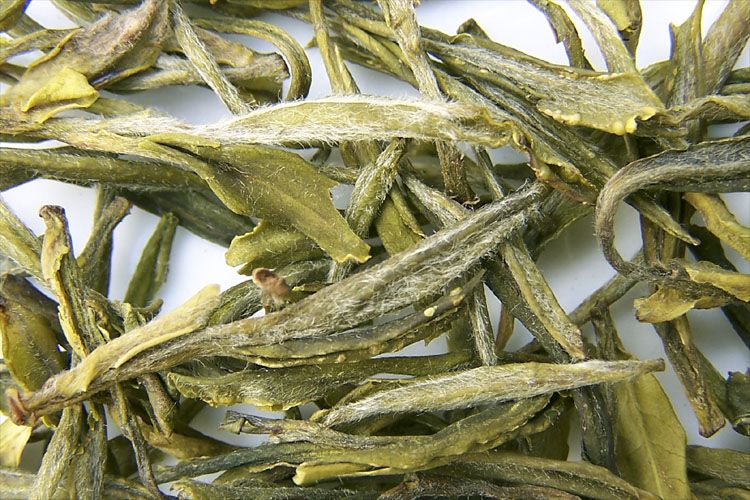
Huang Shan Mao Feng Green tea is a non-fermented tea. In order to stop fermentation, the enzymes - proteins that accelerate biochemical processes - of the tea leaves must be deactivated. In green tea this is usually done by heating. A temperature above 70°C destroys most enzyme activity. If the destruction of the enzyme activities takes place with hot steam, we speak of steamed green tea (Chinese: Zheng Qing). Steamed green teas are now rarely produced in China. In Europe they are represented by the Japanese Sencha and Gyokuro. In most Chinese green teas, the enzymes of the tea leaves are deactivated by direct heating. The leaves are then shaped and finally dried. Depending on the method of final drying, a distinction is made between
- roasted green tea (Chinese: Chao Qing),
- oven-dried green tea (Chinese: Hong Qing) and
- sun-dried green tea (Chinese: Shai Qing),
, whereby drying in the sun is only used for low quality green teas. For roasted green tea, the tea is traditionally roasted in cast-iron pans.
Most Chinese green teas
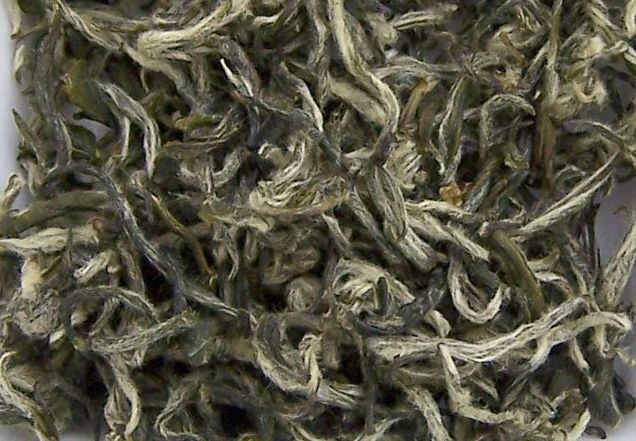
Bi Lo Chun are roasted green teas. The advantage of roasting is the stronger tea scent: the roasting process creates new, not easily volatile scent molecules. The most renowned representatives are Lung Ching und Pi Lo Chun . For oven-dried green tea, the tea leaves are dried in coal-fired ovens. The advantage of oven drying is that the tea leaves do not break so easily during production. This gives the oven-dried green tea a better appearance. The best known representative of these teas is the Huang Shan Mao Feng For some time now, pan roasting and oven drying have sometimes even been combined in the production of high-quality green tea.
In China, a distinction is made between normal green tea and high-quality green tea. While for normal green teas like Gunpowder, the automation of the production has long since been introduced, the high quality green teas are still produced by hand. Furthermore, the high quality green teas are only produced with spring plucking.

Bi Lo Chun are roasted green teas. The advantage of roasting is the stronger tea scent: the roasting process creates new, not easily volatile scent molecules. The most renowned representatives are Lung Ching und Pi Lo Chun . For oven-dried green tea, the tea leaves are dried in coal-fired ovens. The advantage of oven drying is that the tea leaves do not break so easily during production. This gives the oven-dried green tea a better appearance. The best known representative of these teas is the Huang Shan Mao Feng For some time now, pan roasting and oven drying have sometimes even been combined in the production of high-quality green tea.
In China, a distinction is made between normal green tea and high-quality green tea. While for normal green teas like Gunpowder, the automation of the production has long since been introduced, the high quality green teas are still produced by hand. Furthermore, the high quality green teas are only produced with spring plucking.
The yellow Tea
The yellow tea is also not fermented. The name is derived from the colour of the leaves and the infusion. Originally, the yellow tea was probably produced from an improper processing of green tea.
An important step in the production of steamed green tea is the immediate aeration and cooling after the steam bath.
If the tea is not aired in time after the steam bath, the high humidity and heat favour the spontaneous oxidation (in contrast to the enzymatic oxidation or fermentation in the case of oolong and black tea) of the catechins by the atmospheric oxygen.
In addition, the chlorophyll (the leaf green) decomposes. The leaf dye xanthophyll (yellow, also called lutein), which is normally covered by the chlorophyll, is revealed.
Both reactions lead to the yellow colouring of the leaves and the infusion. Later, a virtue was made of necessity and these poorly processed green teas were sold as a special variety.
Nevertheless, yellow tea remains a rather inferior tea. The production of yellow teas is very low. Actually, hardly any Chinese knows the yellow teas which are praised as specialties in the West.
The white tea
White tea is distinguished between the traditional white teas and the "white tea from Anji".
The white tea from Anji
In some books from the Song Dynasty, a special tea plant
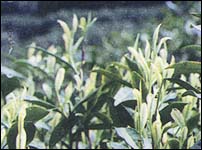
White tea from Anji which should have white leaves. The tea from it was called "white tea". What sounds very absurd at first was confirmed by a discovery in the 80s. In a mountain in Zhejiang
Zhejiang
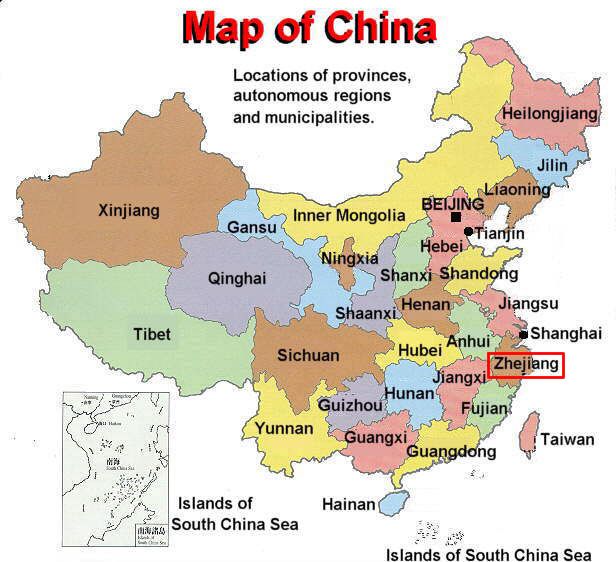 province, a tea plant more than 100 years old was discovered.
The special feature of this plant is that the colour of the leaves changes from green to white when the leaf buds open. When the leaves get older, they take on the green colour again.
This play of colours only occurs in spring when the temperature is still between 20 - 22 °C. When the colour changes, the chlorophyll (leaf green) content in the young leaves suddenly decreases.
This colour change seems to be caused by a genetic defect.
In addition to the colour change, the breakdown of proteins increases, which leads to a particularly high content of amino acids, which are essential for the flavour of a tea.
province, a tea plant more than 100 years old was discovered.
The special feature of this plant is that the colour of the leaves changes from green to white when the leaf buds open. When the leaves get older, they take on the green colour again.
This play of colours only occurs in spring when the temperature is still between 20 - 22 °C. When the colour changes, the chlorophyll (leaf green) content in the young leaves suddenly decreases.
This colour change seems to be caused by a genetic defect.
In addition to the colour change, the breakdown of proteins increases, which leads to a particularly high content of amino acids, which are essential for the flavour of a tea.

White tea from Anji which should have white leaves. The tea from it was called "white tea". What sounds very absurd at first was confirmed by a discovery in the 80s. In a mountain in
 Zhejiang
Zhejiang

A large number of plants have been obtained from this tea plant through cuttings. The tea from this plant is called "White tea from Anji".
Anji is the city where these tea plants are grown (please do not confuse this with the city of Anxi in Fujian).
Note: the summer and autumn plucks of this tea are normally green.
According to the production process the white tea from Anji is actually a green tea, it is produced in the same way as the roasted green teas.
Traditional white teas
The name "white tea" is derived from the fine white hairs on the back of the leaves and buds. The tea is otherwise not white, and the infusion is also not white but light yellow.
White tea is a lightly fermented tea, it is produced exclusively in China.
For a high quality white tea (e.g.
Bai Hao Yin Zhen
, silver needle with white hairs), very fine buds are plucked at the beginning of spring, which are either still unopened or only have a single leaf that is not yet fully unfolded.
Only in this way do the buds bear the still very fine hairs that are characteristic of white tea.
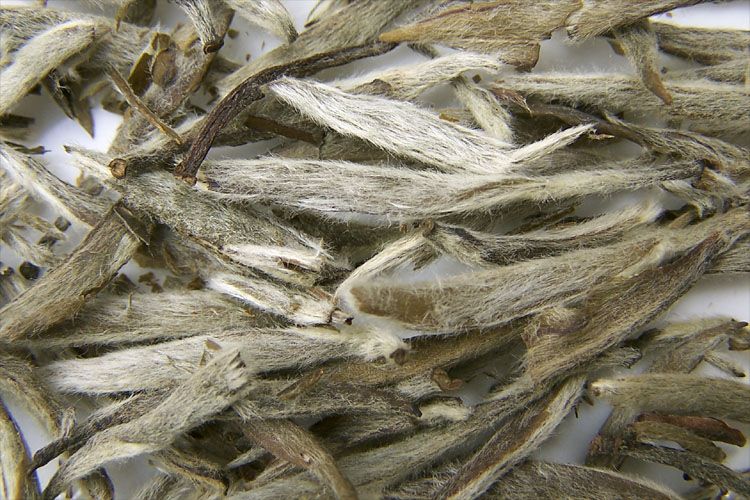 Bai Hao Yin Zhen (White hair silver needles). The name " white tea" comes from the thick white fluff on the back of the leaf buds.
Bai Hao Yin Zhen (White hair silver needles). The name " white tea" comes from the thick white fluff on the back of the leaf buds.
The leaf is then separated from the bud and is used for normal white tea. For the tea variety Bai Mu Dan (White Peony), buds with two young leaves are plucked. Here too, it is important that both buds and leaves have fine hairs.
For processing, the buds are either pre-dried in the sun for 8 - 9 hours and then finally dried at a temperature of about 40°C, or they are left to wilt in the shade and then dried in strong sunlight.
Oolong Tea
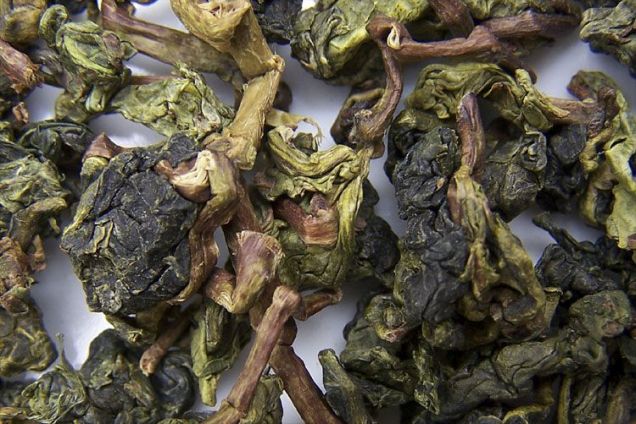
Ti Kuan Yin Nobody knows exactly how and when the oolong was created in China. Some historians claim to have found evidence of the origin of the oolong as early as the Song Dynasty (10th-13th centuries). The only certainty is that it originated in the province
 Fujian
Fujian
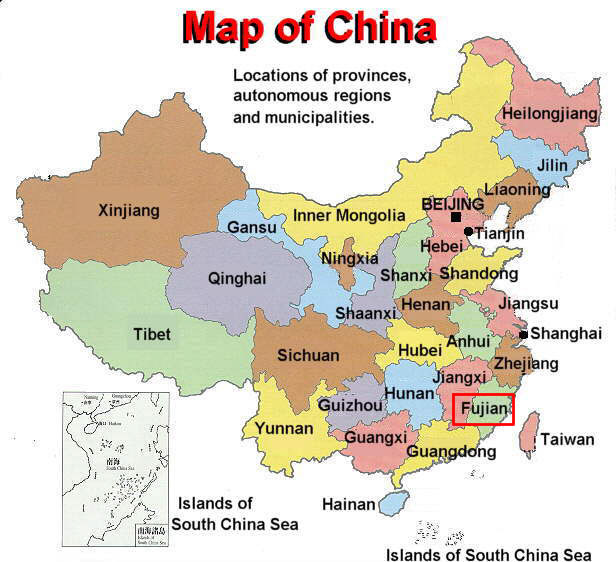
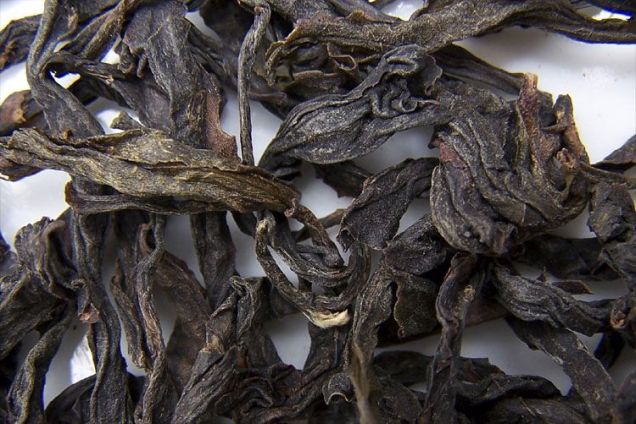
Rock tea The Oolong is a semi-fermented tea. Depending on the degree of fermentation the Oolong has a dark green to almost black colour. Infused leaves typically show a dark green colour with a red border. The red border results from the injuries that leaves have suffered during production. As a result of the injuries, the enzymes are released from the leaf cells and get direct access to atmospheric oxygen. This favours fermentation at the sites of injury and the formation red dyes like thearubigine.
The production of Oolong is much more complex than for green tea and usually involves steps such as pre-drying/wilting, fermentation, roasting, rolling, drying and several repetitions of some of these steps. Depending on the degree of fermentation, a distinction is made between the classic Oolong from Fujian (Ti Kuan Yin and Da Hong Pao), the Dong Ding oolong from
 Southern Taiwan
Southern Taiwan
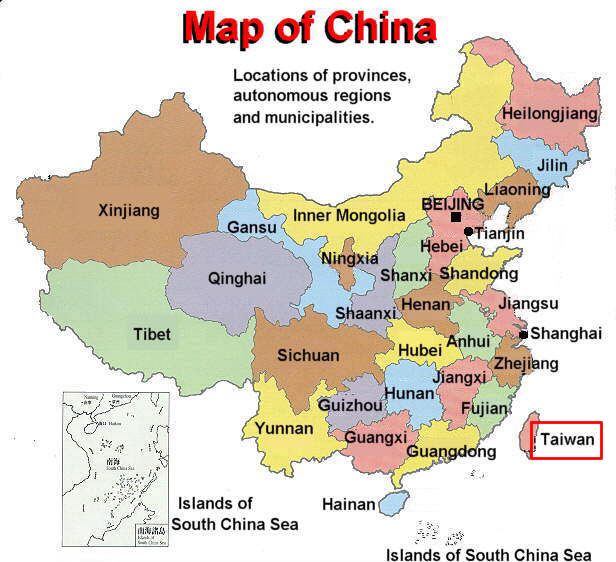
Black/red tea
What is known as "black tea" in the West is called "red tea" in China, probably because of the colour of the infusion.
The English term "black tea" refers to the colour of the dry tea leaves. The term "black tea" is used elsewhere in China (see below).
The origin of black tea can also be found in the province of
 Fujian
Fujian
 .
Today it is produced in most of the southern Chinese provinces.
Black tea is a fully fermented tea. During fermentation, the catechins (polyphenols) are oxidised by oxygen, catalysed by oxidase (oxidation accelerating enzymes) of the tea leaves, to theaflavines (yellow) and thearubigines (red).
Both dye groups are responsible for the pleasant, sweetish taste of black tea. The chlorophyll, the leaf green, loses the magnesium ion in the molecule due to fermentation and thus also the green colour.
The tea plant variation Camellia sinensis Var. assamica, which is mainly grown in south-west China and India, contains considerably more catechins than the Chinese variation and is therefore better suited for the production of black tea.
.
Today it is produced in most of the southern Chinese provinces.
Black tea is a fully fermented tea. During fermentation, the catechins (polyphenols) are oxidised by oxygen, catalysed by oxidase (oxidation accelerating enzymes) of the tea leaves, to theaflavines (yellow) and thearubigines (red).
Both dye groups are responsible for the pleasant, sweetish taste of black tea. The chlorophyll, the leaf green, loses the magnesium ion in the molecule due to fermentation and thus also the green colour.
The tea plant variation Camellia sinensis Var. assamica, which is mainly grown in south-west China and India, contains considerably more catechins than the Chinese variation and is therefore better suited for the production of black tea.
 Fujian
Fujian

The classical Chinese black tea includes the Kongfu black tea (in the West: Congou tea) and the small-leaved black tea, whereby the Kongfu tea is more widely known in the West than the small-leaved black tea.
Until 1886, the world market for tea was dominated by Kongfu tea from China. The smuggling of the tea plant and the poaching of tea specialists by the English into India and the many civil wars abruptly ended China's dominant position.
Only in 2003 did China catch up with India in terms of tea exports. But today the number one tea exporting nation is neither China nor India, but Sri Lanka.
The black tea
Chinese black tea, not to be confused with the black tea known in Europe, is, with a few exceptions, an inferior tea. Like yellow tea,
black tea was originally created by the faulty production of green tea.
If the enzymes in the leaves are not completely deactivated, the remaining enzyme activities may cause the tea to ferment during storage. The same process as with Oolong or black tea, but much slower.
In addition, micro-organisms carried by the tea also contribute to the fermentation process. This is also the reason why black tea gains in quality and flavour through storage. In China black tea is also classified as post-fermented tea.
In the Ming period (14th - 17th century) black tea was mainly produced for the exchange trade with the nomads. Since the decline of the Tang Dynasty, China has increasingly renounced the breeding of horses.
For military purposes, horses were bought from nomads north and west of China. As black tea had a relatively long shelf life, it was very popular with the nomads.
The tea vs. horse business was therefore a profitable business for both sides.
The most famous black tea is probably Pu Erh tea.
It comes from
 Yunnan
Yunnan
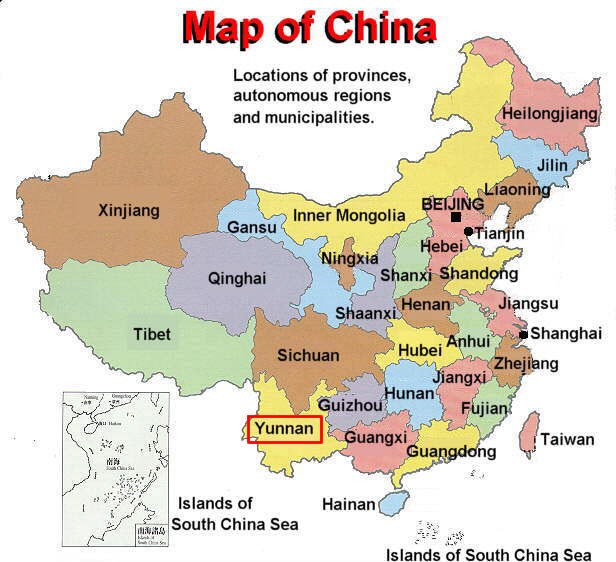 province. The name Pu Erh tea comes from the name of the district town Pu Erh, the commercial centre for this tea variety.
province. The name Pu Erh tea comes from the name of the district town Pu Erh, the commercial centre for this tea variety.
 Yunnan
Yunnan

The flavoured tea
Flavoured tea has a long history in China. As early as the 11th century, jasmine flowers were added to tea production. Later, the tea was also flavoured with fine strips of orange peel. Osmanthus and gardenia blossoms are also used in aromatic teas.
Today, flavoured tea is only made from green tea. The flavoured tea is mainly drunk in northern China.
The green tea works of art
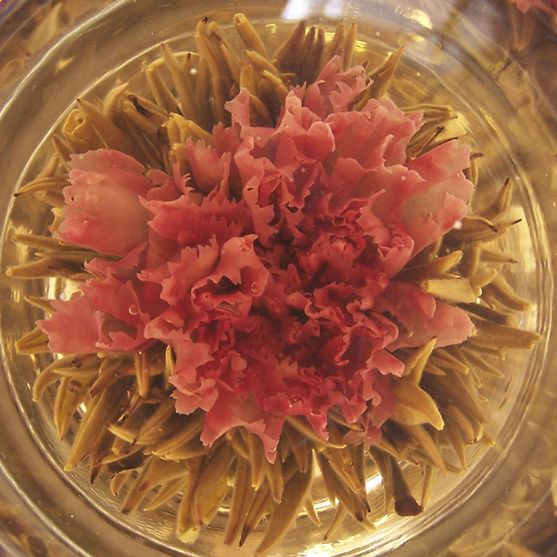
Green tea artworks Some years ago a new tea variety came into fashion in China: the "Kong Yi Cha". Directly translated it is called "art tea". This means tea specialities from the Huang Shan region (The Yellow Mountain), which are created by artfully designing the tea leaves. Almost all art teas are made from green tea. The famous Huang Shan Mao Feng serves as the basic material, along with Lung Ching and Pi Lo Chun, the best Chinese green tea. The best spring pickings between the end of March and the beginning of April are tied together with twine threads to form shapes like cone, ball or peach. In the bundles are hidden flowers like chrysanthemum, ball amaranth, jasmine or even carnation. Both the green tea and the tea containers are 100% handmade. The tea containers literally blossom when infused. Only now are the flowers released from their hiding place for viewing. An absolutely fascinating spectacle. The fine flowery taste of Huang Shan Mao Feng rounds off the unique tea experience. A must for every tea lover, but also ideal as a gift idea. More pictures of these rarities can be seen here.

